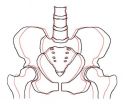(Press-News.org) CHAPEL HILL, N.C. – By the age of 20, most people have reached skeletal maturity and do not grow any taller. Until recently it was assumed that skeletal enlargement elsewhere in the body also stopped by age 20.
But a new study by researchers at the University of North Carolina at Chapel Hill has found evidence that, even though you're not getting taller anymore, the pelvis ("hipbones") does continue to widen as people advance in age from 20 years to 79 years.
"I think it's a fairly common human experience that people find themselves to be wider at the age of 40 or 60 then they were at 20," said Laurence E. Dahners, MD, senior author of the study and a professor in the Department of Orthopaedics in the UNC School of Medicine. "Until recently we assumed that this was caused simply by an increase in body fat.
"Our findings suggest that pelvic growth may contribute to people becoming wider and having a larger waist size as they get older, whether or not they also have an increase in body fat," Dahners said.
The pelvic width of the oldest patients in the study was, on average, nearly an inch larger than the youngest patients. This one-inch increase in pelvic diameter, by itself, could lead to an approximately three-inch increase in waist size from age 20 to age 79. If the rest of the body is widening commensurately, this might account for a significant portion of an increase in body weight of about one pound a year that many people experience during the same period, Dahners said.
Dahners and his UNC co-authors got the idea for the study, which was published online on May 23, 2011 by the Journal of Orthopaedic Research, after being surprised to see evidence of pelvic widening in X-rays from patients in an unrelated bursitis study. They searched the scientific literature and found no previous studies that directly examined whether or not the skeleton continues to widen after skeletal maturity.
So, they set out to examine that question themselves. They did so by using CT scans from 246 randomly selected patients to measure the width and height of the L4 vertebral body (as an indication of whether these patients were taller and larger overall), the width of the pelvic inlet (the birth canal opening in the middle of the pelvis), the distance between the femoral heads (hip joints) and the diameters of the femoral heads.
There were approximately 20 male and 20 female patients in each 10-year age group, from the 20-29 age group to the 70-79 age group.
Their results confirmed that the width of the pelvis, the width but not the height of L4 vertebral body, the distance between the femoral heads and the diameter of the femoral heads all continued to enlarge after skeletal maturity.
In particular, the fact that the pelvic inlet also widened is evidence of true pelvic growth rather than simple appositional bone formation, Dahners said. The pelvic inlet would be smaller if appositional bone formation were taking place, he said.
INFORMATION:
First author of the study is Alexander A. Berger, a UNC medical student. Co-authors are Ryan May, a doctoral student in the UNC Gillings School of Global Public Health, Jordan B. Renner, MD, a professor in the departments of Radiology and Allied Health Sciences in the UNC School of Medicine, and Neal Viradia, an MD/MPH student at UNC.
Pelvic widening continues throughout a person's lifetime, UNC study
2011-05-26
ELSE PRESS RELEASES FROM THIS DATE:
Mating rivalry among furred and feathered: Variety is spice of life
2011-05-26
This press release is available in French.Montreal, May 25, 2011 – Birds do it. Bees do it. Fish, lobsters, frogs and lizards do it, too. But when it comes to securing a mate in the animal world, variety is literally the spice of life.
A group of scientists from Simon Fraser University, Concordia University and Dalhousie University has found flexibility in mating rituals is the key to reproductive success when males outnumber females.
The research team pored through hundreds of investigations on mating trends in mammals, insects, fish, crustaceans, amphibians and reptiles. ...
Defect in graphene may present bouquet of possibilities
2011-05-26
A class of decorative, flower-like defects in the nanomaterial graphene could have potentially important effects on the material's already unique electrical and mechanical properties, according to researchers at the National Institute of Standards and Technology (NIST) and Georgia Tech. In a new paper,* the team for the first time describes a family of seven defects that could occur naturally or be induced to occur in graphene, one of which already has been observed.
Graphene is renowned for its strength and conductivity, both of which are a result of its structure. For ...
New software tool helps evaluate natural cooling options for buildings
2011-05-26
A new, free software tool from the National Institute of Standards and Technology (NIST) could prove to be a breath of fresh air for architects and designers of ventilation systems for "green" commercial buildings.
With the Climate Suitability Tool,* building design teams can evaluate whether the local climate is suitable for cooling a prospective building with natural ventilation or requires a hybrid system that supplies supplemental cooling capacity. The tool is based on a model of the heat-related characteristics of a building configured to take full advantage of ambient ...
NIST 'nanowire' measurements could improve computer memory
2011-05-26
A recent study* at the National Institute of Standards and Technology (NIST) may have revealed the optimal characteristics for a new type of computer memory now under development. The work, performed in collaboration with researchers from George Mason University (GMU), aims to optimize nanowire-based charge-trapping memory devices, potentially illuminating the path to creating portable computers and cell phones that can operate for days between charging sessions.
The nascent technology is based on silicon formed into tiny wires, approximately 20 nanometers in diameter. ...
Fish species discovered by LSU researcher makes 2011 top 10 list
2011-05-26
BATON ROUGE – The International Institute for Species Exploration at Arizona State University and a committee of taxonomists from around the world announced their picks for the top 10 new species described in 2010. Among their top picks is Halieutichthys intermedius, a pancake batfish recently discovered by Prosanta Chakrabarty, curator of fishes at LSU's Museum of Natural Science, and colleagues.
Halieutichthys intermedius, more commonly referred to as the Louisiana pancake batfish, gained some notoriety during the spring and summer of 2010, when the Deepwater Horizon ...
Public universities place greater focus on internal research services than public ones do
2011-05-26
Research expenditure has increased in Spain, as has the focus on research performance. However, the internal services that universities provide to support research, both in terms of infrastructure and staff, have not improved, according to a study published in the journal The Service Industries Journal, which also shows that public universities outperform private ones in this respect.
"The Ministry of Science and Innovation provides Spanish universities with access to databases. However, we have seen that in many cases there are no research support staff to explain how ...
New study provides global analysis of seagrass extinction risk
2011-05-26
A team of 21 researchers from 11 nations, including professor Robert "JJ" Orth of the Virginia Institute of Marine Science, has completed the first-ever study of the risk of extinction for individual seagrass species around the world.
The 4-year study, requested by the International Union for the Conservation of Nature (IUCN), shows that 10 of the 72 known seagrass species (14%) are at an elevated risk of extinction, while 3 species qualify as endangered.
The authors caution that loss of seagrass species and seagrass biodiversity will seriously impact marine ecosystems ...
Improved prognosis for esophageal cancer
2011-05-26
In recent years, the number of cases of adenocarcinoma of the esophagus (or gullet) has been on the rise. At the same time, however, new ways of treatment are improving the outlook for patients. In the current issue of Deutsches Ärzteblatt International (Dtsch Artzebl Int 2011; 108[18]: 313), Angelika Behrens and her working group report on innovations in diagnosis and treatment.
The main cause of this cancer is reflux of gastric acid from the stomach, with heartburn as the main symptom. Other risk factors are being male, being overweight, and having relatives ...
New bandwidth management techniques boost operating efficiency in multi-core chips
2011-05-26
Researchers from North Carolina State University have developed two new techniques to help maximize the performance of multi-core computer chips by allowing them to retrieve data more efficiently, which boosts chip performance by 10 to 40 percent.
To do this, the new techniques allow multi-core chips to deal with two things more efficiently: allocating bandwidth and "prefetching" data.
Multi-core chips are supposed to make our computers run faster. Each core on a chip is its own central processing unit, or computer brain. However, there are things that can slow these ...
Global warming may affect the capacity of trees to store carbon, MBL study finds
2011-05-26
MBL, WOODS HOLE, MASS.—One helpful action anyone can take in response to global warming is to plant trees and preserve forests. Trees and plants capture carbon dioxide during photosynthesis, thereby removing the most abundant greenhouse gas from the atmosphere and storing some of it in their woody tissue.
Yet global warming may affect the capacity of trees to store carbon by altering forest nitrogen cycling, concludes a study led by Jerry Melillo, Distinguished Scientist at the Marine Biological Laboratory (MBL) Ecosystems Center, and published this week in Proceedings ...





